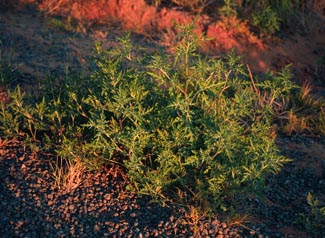Western Ragweed

Common Name(s):
Western Ragweed
Ragweed
Cuman Ragweed
Scientific Name:
Ambrosia psilostachya DC.
Scientific Name Synonyms:
Ambrosia californica Rydb.
Symbol:
AMPS
Description:
Life Span: Annual or Perennial
Origin: Native
Season: Warm
Growth Characteristics: Western ragweed's main stem rises from shallow or deep, branching rhizomes which extend down 3 to 6 feet. Stems are slender and branched, usually 1 to 2 feet tall.
Flowers/Inflorescence: Generally inconspicuous male flowers occur in small heads on the upper part of the flowering stalks, mostly in August and September. Female flower heads are few and clustered near the base of the flowering stalks at the point of attachment of the upper leaves.
Fruits/Seeds: Fruit is an achene with a short beak and small blunt tubercles on top.
Leaves: Opposite, becoming alternate above. Most of the leaves are rough-surfaced and deeply pinnately lobed in irregular patterns.
Ecological Adaptions:
Western ragweed grows on dry prairies, blowouts, hills, and in washouts, sandy woods, and meadows. It is also a widespread weed in waste places, roadsides, railroads, overgrazed rangeland, and other disturbed areas. Western ragweed is not drought resistant.
Western ragweed colonizes sites by means of spreading rhizomes, allowing it to propagate when conditions are unfavorable to seedling establishment.
Soils: Found on a variety of soils, but does best on loam soils.
Associated Species: Russian thistle, curlycup gumweed.
Uses and Management:
Because of their bitter taste, ragweeds are seldom grazed. The bitter taste is due to the foliage and stems containing cinnamic acid and sesquiterpene lactones. However, western ragweed is not considered a poisonous plant. Still, it is moderately important as ungulate forage. Western ragweed is used for food and nesting material, and as a habitat component by small mammals and nongame birds.
Western ragweed is a major invader of deteriorating rangeland. It readily moves into open habitat.
All ragweeds produce abundant pollen, a primary hay fever producing agent in late summer. Tea made from the leaves was used by American Indians to relieve swelling and to stop vomiting. Tea was also used to treat bowel cramps, bloody stools, and colds. It was also made into a salve to treat skin sores of man and horses.

